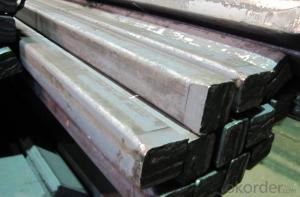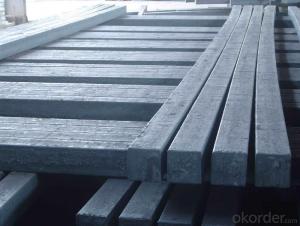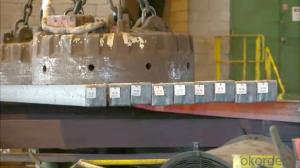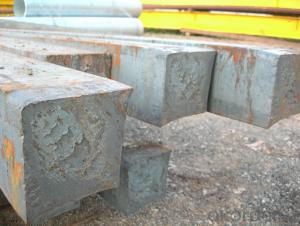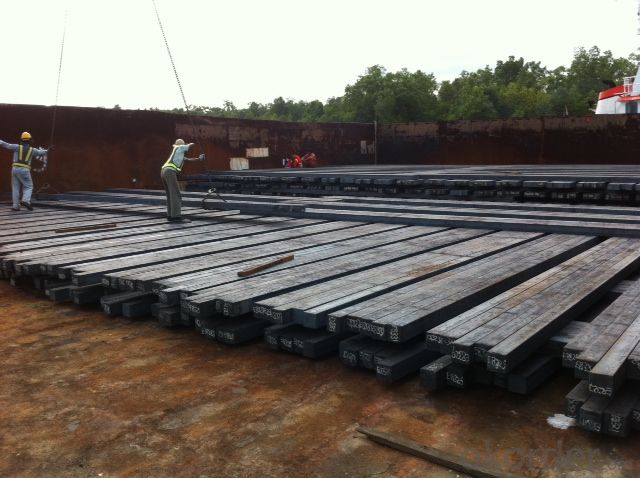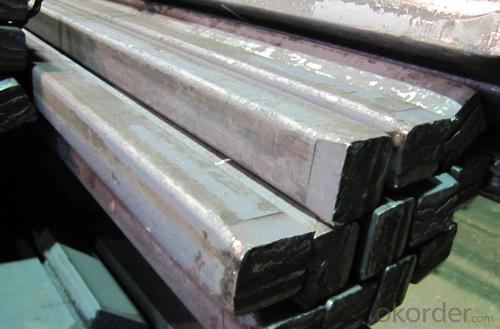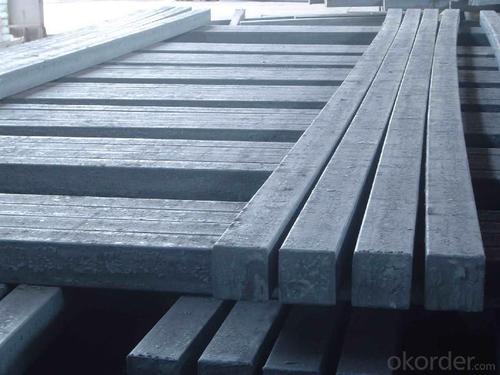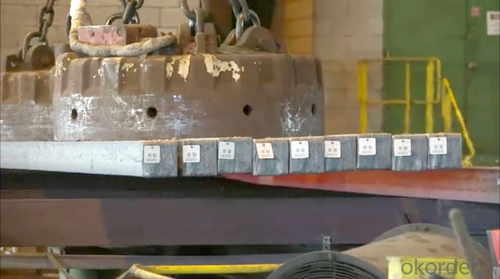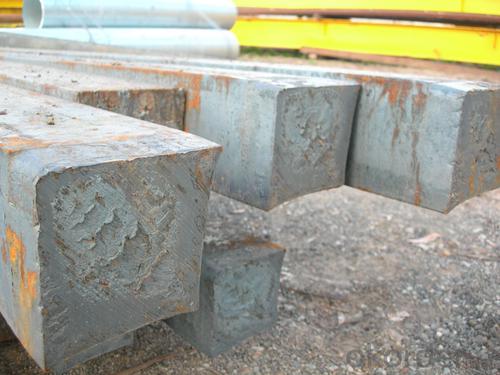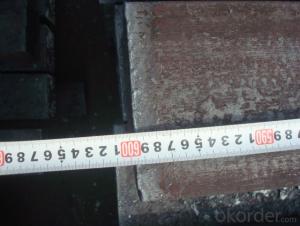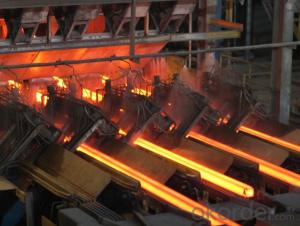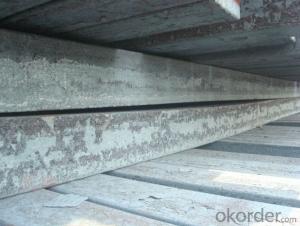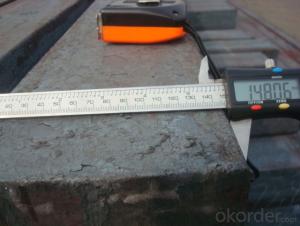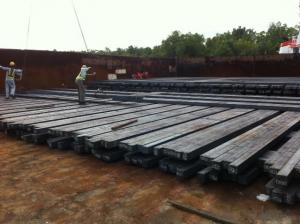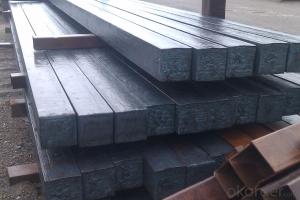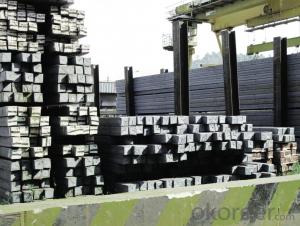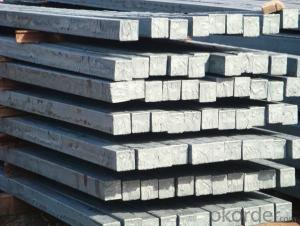Prime square alloy steel billet 150mm Q235
- Loading Port:
- Shanghai
- Payment Terms:
- TT OR LC
- Min Order Qty:
- 100 m.t.
- Supply Capability:
- 10000 m.t./month
OKorder Service Pledge
OKorder Financial Service
You Might Also Like
Structure of Prime square alloy steel billet 150mm Q235
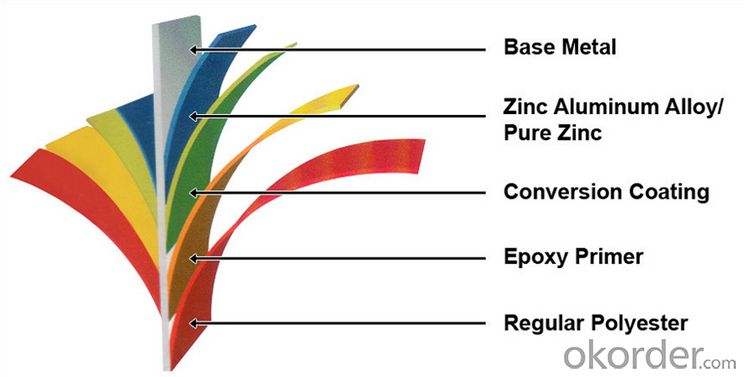
Description of Prime square alloy steel billet 150mm Q235
1) Excellent corrosion resistance: The zinc layer provides a good protection of Pre-painted Galvanizeed Steel Sheet.
2) High heat resistance: The reflective surface of the material aids in efficiently reflecting the sunlight away and in turn reducing the amount of heat transmitted. The thermal reflectivity converts into energy savings.
3) Aesthetics: Pre-Painted Galvanized steel sheet is available in plethora of patterns and multiple sizes as per the requirements that given by our customers.
4) Versatility: can be used in the various areas.

Main Feature of Prime square alloy steel billet 150mm Q235
Uncoated CR steel sheet
With the features of in line with the international highest standards in demension and shape, excellent surface finish and properties, the products are mainly used in home appliance and automobile industries.
Galvanized steel sheet(include HDG and EG)
With the features of good corrosion resistance, the products are mainly used in automobile, home appliance, electronics, building and machinery manufacture industries, etc.
Precoated steel sheet
With the features of enviromental protection and good processablility, long lasting surface durability, rich in colors, the products are maily used in building, home appliance and furniture industries, etc.
Applications of Prime square alloy steel billet 150mm Q235
1) Excellent corrosion resistance: The zinc layer provides a good protection of Pre-painted Galvanizeed Steel Sheet.
2) High heat resistance: The reflective surface of the material aids in efficiently reflecting the sunlight away and in turn reducing the amount of heat transmitted. The thermal reflectivity converts into energy savings.
3) Aesthetics: Pre-Painted Galvanized steel sheet is available in plethora of patterns and multiple sizes as per the requirements that given by our customers.
4) Versatility: can be used in the various areas.
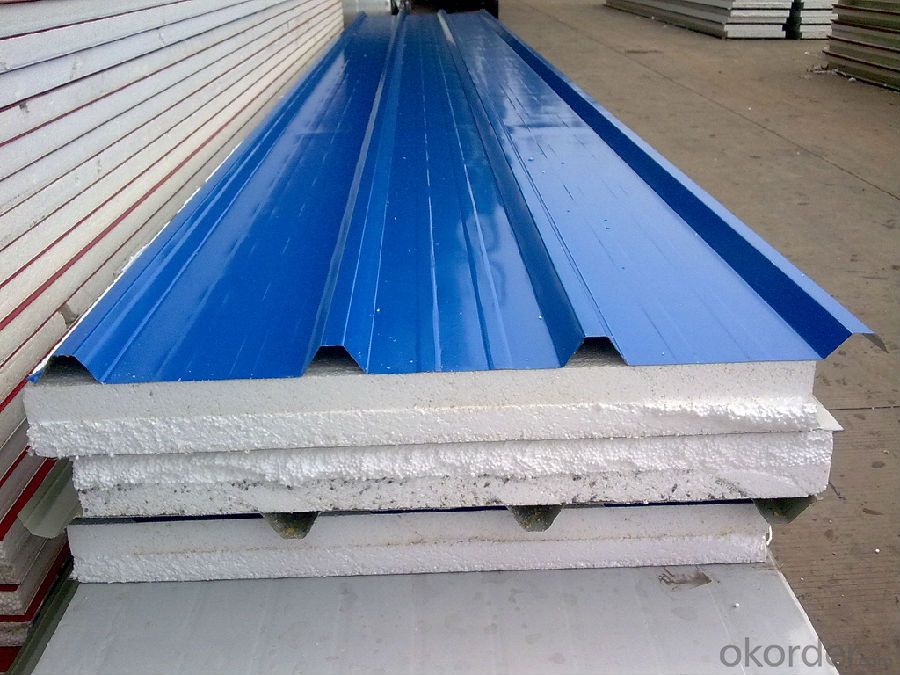
Specifications of Prime square alloy steel billet 150mm Q235
Product | Billet |
Material Grade | SGCC / SGCH / DX51D+AZ, etc |
Thickness | 0.6-3.0mm |
Width | 500-1500mm |
Tolerance | Thickness: +/-0.02mm , Width:+/-2mm |
Zinc-coating | Z30-150g/m2 |
Technique | Raw material: Hot rolled steel coil --> Cold rolled_>hot dipped galvalume |
Surface | Dried, Chromated, Unoiled |
Spangle | Regular spangle , small spangle, zero spangle |
ID | 508MM 610MM |
Coil weight | 1-25MT |
Export package | Cardboard inner sleeves, Waterproof paper, galvanized steel covered and steel strip packed |
FAQ of Prime square alloy steel billet 150mm Q235
We have organized several common questions for our clients,may help you sincerely:
1. How Can I Visit There?
Our company is located in Tianjin City, China, near Beijing. You can fly to Tianjin Airport Directly. All our clients, from home or aboard, are warmly welcome to visit us!
2. How Can I Get Some Sample?
We are honored to offer you sample.
3. Why choose CNBM?
we always fix steel produce in container well to make it safe arrive at destination port
we always provide best and professional forward service for our buyer
we always apply 14days free detention for our buyers container in destination
we provide one set After-sales service for our buyer
we provide China inland steel market price report
we help our buyer become number one in local market .
- Q: What are the main advantages of using steel billets in manufacturing?
- Using steel billets in manufacturing offers numerous advantages. Firstly, their exceptional strength and durability make them ideal for producing products that require high tensile strength and resistance to wear and tear. Whether it's automotive parts, construction materials, or industrial equipment, steel billets provide the necessary strength and reliability. Secondly, steel billets offer excellent machinability, allowing them to be easily shaped, cut, and formed into different shapes and sizes. This versatility in manufacturing processes enables the creation of complex and intricate designs with precision, ensuring the production of high-quality finished goods. Furthermore, steel billets possess excellent thermal conductivity and can withstand extreme temperatures. This makes them valuable in industries that require heat resistance, such as the production of heat exchangers, boilers, and other industrial applications. The ability of steel billets to maintain their structural integrity even under high temperatures makes them highly reliable in demanding manufacturing environments. Additionally, steel billets are readily available and cost-effective. Steel is widely used in manufacturing, making it easily accessible in the market. The abundance of steel billets ensures a consistent supply, reducing production delays and costs associated with sourcing materials. Lastly, steel billets have excellent corrosion resistance, making them suitable for manufacturing products exposed to harsh environmental conditions or corrosive substances. By utilizing steel billets, manufacturers can ensure that their products maintain their integrity and functionality even in challenging environments. To conclude, the main advantages of using steel billets in manufacturing include their exceptional strength, machinability, thermal conductivity, availability, cost-effectiveness, and corrosion resistance. These qualities make steel billets the preferred choice for various industries, enabling the production of high-quality, durable, and reliable products.
- Q: What are the common sizes and shapes of steel billets?
- To cater to the diverse needs of different industries, steel billets are typically manufactured in various sizes and shapes. The most common sizes range from 100mm to 200mm in width and 100mm to 300mm in height. However, it should be noted that these dimensions can vary based on the specific requirements of the end-user or the steel manufacturer. Regarding shapes, rectangular and square shapes are commonly produced. Rectangular billets have flat and smooth surfaces with four right angles, while square billets have equal sides with four right angles as well. These shapes are preferred because they facilitate easier handling, transportation, and further processing of the steel billets. Furthermore, steel billets can also be produced in non-traditional shapes such as round, hexagonal, or octagonal, depending on the intended application. These unique geometries are often utilized in specialized industries like automotive or aerospace manufacturing to meet specific design requirements. It is important to mention that the sizes and shapes of steel billets can vary across different regions and industries, as each may have their own specific standards and preferences. Therefore, manufacturers and end-users should communicate and align their requirements to ensure the production of steel billets that meet their respective needs.
- Q: What are the challenges faced in steel billet manufacturing?
- Steel billet manufacturing encounters various challenges. One of the primary obstacles is the attainment of consistent quality and uniformity in the billets. The billets must possess precise chemical composition and physical properties to meet the requirements of the end products. However, fluctuations in raw materials, like iron ore and scrap metal, can influence the billets' quality. Ensuring consistent quality throughout the production process is crucial but is difficult due to the variable nature of the raw materials. Another challenge lies in ensuring the appropriate heat treatment of the billets. Heat treatment is necessary to enhance the mechanical properties of the steel billets, but it demands precise control over temperature, time, and cooling rates. Any deviation from the recommended heat treatment process can lead to inconsistent mechanical properties, resulting in a decline in the overall billet quality. Furthermore, the production of steel billets involves intricate and energy-intensive processes. Manufacturing facilities must possess advanced equipment and technology to handle the high temperatures required for melting and casting the steel. The continuous casting process, commonly used for billet production, necessitates precise control over various parameters, such as casting speed and cooling rates. Maintaining the equipment and ensuring its proper functioning can be a challenge in itself. Moreover, environmental concerns present challenges in steel billet manufacturing. The process generates significant emissions of greenhouse gases, particulate matter, and other pollutants. Stricter environmental regulations and the need to reduce the carbon footprint of the manufacturing process require steel producers to invest in energy-efficient technologies and implement sustainable practices. Lastly, the market demand for steel billets can be volatile, posing challenges in production planning and inventory management. Demand fluctuations can result in overproduction or stockouts, impacting the overall efficiency and profitability of the manufacturing process. Overall, steel billet manufacturing encounters challenges related to maintaining consistent quality, achieving proper heat treatment, managing energy-intensive processes, addressing environmental concerns, and adapting to market dynamics. Overcoming these challenges necessitates continuous improvement, technological investments, and adherence to stringent quality standards.
- Q: What are the different methods of steel billet surface grinding?
- There are several methods of steel billet surface grinding, including abrasive grinding, belt grinding, and centerless grinding.
- Q: How do steel billets contribute to the fire resistance of a structure?
- Steel billets contribute to the fire resistance of a structure primarily due to their high melting point and ability to conduct heat. Steel, in general, has a melting point of around 1370-1538 degrees Celsius (2500-2800 degrees Fahrenheit), which is significantly higher than other commonly used building materials such as wood or concrete. During a fire, the high melting point of steel billets allows them to withstand intense heat without losing their structural integrity. This means that even when exposed to high temperatures, the steel framework of a building will not warp, soften, or collapse easily, reducing the risk of structural failure. Furthermore, steel is a good conductor of heat, which helps dissipate the heat generated during a fire. When steel is exposed to fire, it quickly absorbs the heat and conducts it away from the affected area, preventing the fire from spreading and minimizing the damage to the structure. This heat dissipation property also helps to prevent the transfer of heat to other non-steel components of the building, such as walls or floors, which could otherwise contribute to the fire's rapid spread. In addition to their high melting point and heat conduction properties, steel billets also have a low thermal expansion coefficient. This means that even when exposed to extreme heat, steel expands at a relatively slow rate compared to other materials. This characteristic helps to prevent excessive movement or deformation of the steel structure during a fire, ensuring that the building maintains its stability and structural integrity. Overall, steel billets play a crucial role in enhancing the fire resistance of a structure by offering high heat resistance, efficient heat conduction, and minimal thermal expansion. These properties make steel an ideal choice for constructing fire-resistant buildings, providing increased safety for occupants and reducing the risk of total or partial collapse during a fire event.
- Q: What are the different types of steel billet rolling mill equipment?
- In the manufacturing process, a variety of equipment is utilized in the steel billet rolling mill. Here are some of the most commonly used types: 1. To achieve the necessary temperature for rolling, steel billets are heated using reheating furnaces. These furnaces utilize either fuel or electricity to generate the required heat, ensuring that the billets reach the optimal temperature. 2. In order to reduce the billet size and prepare them for subsequent rolling passes, roughing stands are employed. These stands consist of multiple rolls that gradually decrease the billet thickness as they pass through. 3. Once the roughing process is complete, the billets proceed to the intermediate stands. Here, the billets undergo further thickness reduction and are shaped into the desired profile. 4. The billets then move on to the finishing stands, which possess a set of rolls responsible for giving the steel its final shape and size. These stands play a crucial role in achieving precise dimensions and the required surface finish. 5. Cooling beds are utilized to gradually cool down the steel billets after the rolling process. This controlled environment ensures that the billets do not experience any distortion or cracking before further processing. 6. Shearing machines are employed to cut the rolled steel billets into specific lengths. These machines, whether hydraulic or mechanical, guarantee precise and accurate cutting according to the desired specifications. 7. Straightening machines are used to correct any slight deformations or unevenness in the rolled billets. Their purpose is to ensure that the steel is straight and ready for further processing. 8. Various inspection equipment, including ultrasonic testers, are employed to assess the quality and integrity of the rolled steel billets. These equipment guarantee that the final product meets the necessary standards and specifications. In summary, these various types of steel billet rolling mill equipment work in harmony to transform raw steel billets into finished products with the desired shape, size, and quality. The selection and arrangement of these equipment depend on the specific requirements of the manufacturing process and the intended end product.
- Q: What is the role of steel billets in the manufacturing of conveyor belts?
- The manufacturing process of conveyor belts heavily relies on steel billets, which are essential in creating the various components of the belt. These billets, derived from molten steel, serve as the initial stage in production. To begin, the steel billets undergo heating and rolling processes to form thin sheets or strips, depending on the desired thickness of the conveyor belt. These sheets are then further processed to construct the core structure of the belt, providing the necessary strength and durability to withstand demanding conditions. Moreover, steel billets play a crucial role in producing the metal reinforcements within the belt. These reinforcements, typically in the form of steel cords or wires, are embedded into the belt to enhance its tensile strength, preventing stretching or breaking under heavy loads and ensuring longevity and reliability. Additionally, steel billets are utilized in manufacturing the pulley system of the belt. Pulleys are essential components that facilitate the movement of materials along the belt. Made from solid steel billets, these pulleys are machined and designed to smoothly guide the belt while maintaining proper tension. In conclusion, steel billets serve as the foundation for creating the core structure, reinforcements, and pulleys of conveyor belts. Their strength and versatility make them an ideal material for producing belts that can withstand the rigorous conditions of industrial applications, guaranteeing efficient and reliable material handling processes.
- Q: What is a steel billet?
- A steel billet is a semi-finished product in the form of a rectangular or square shape made from molten steel that has been solidified and cooled. It serves as a raw material for various steel products and is further processed through rolling or forging to be transformed into bars, rods, or other desired shapes.
- Q: What are the main factors affecting the mechanical properties of steel billets?
- The main factors affecting the mechanical properties of steel billets include the composition of the steel, the heat treatment process, the grain size, and the presence of impurities or defects in the metal.
- Q: How do steel billets contribute to the overall safety of a structure?
- A structure's overall safety is greatly influenced by steel billets in several ways. To begin with, steel billets act as the raw material for producing steel bars, beams, columns, and other structural components. These components are widely utilized in construction due to their exceptional strength and durability. By utilizing steel billets as the starting material, the resulting steel products display outstanding load-bearing capacity, thereby bolstering the structural integrity of the building. Furthermore, steel billets undergo a rigorous manufacturing process that encompasses various quality control assessments. These assessments ensure that the billets possess consistent and dependable mechanical properties, such as high tensile strength and impact resistance. Consequently, when these billets are employed in constructing a structure, they contribute to its overall safety by providing a dependable and robust framework capable of withstanding external forces like wind, earthquakes, or heavy loads. Additionally, advanced metallurgical techniques, such as controlled cooling or heat treatment, are frequently employed to produce steel billets with specific properties required for structural applications. These processes aid in enhancing the steel's microstructure, reducing internal defects, and improving its resistance to corrosion, fatigue, and other forms of degradation. In turn, this prolongs the structure's lifespan and minimizes the risk of structural failure, ensuring the safety of its occupants. Moreover, steel billets can be manufactured with precise dimensions and tolerances, permitting accurate and efficient construction. This precision in fabrication ensures that structural components fit together seamlessly, reducing the likelihood of gaps, misalignments, or weak points that could compromise the structure's safety. Lastly, steel billets are highly recyclable, making them an environmentally friendly choice for construction. By opting for steel billets, the construction industry can diminish its carbon footprint and contribute to sustainable development. This focus on sustainability aligns with the structure's overall safety, as a sustainable approach guarantees the long-term stability and resilience of the built environment. In conclusion, steel billets enhance the overall safety of a structure by providing construction materials that are strong, durable, and reliable. Their consistent mechanical properties, resistance to external forces, improved microstructure, and precise fabrication ensure a sturdy and secure framework. Additionally, their recyclability promotes sustainability, further enhancing the structure's long-term safety and integrity.
Send your message to us
Prime square alloy steel billet 150mm Q235
- Loading Port:
- Shanghai
- Payment Terms:
- TT OR LC
- Min Order Qty:
- 100 m.t.
- Supply Capability:
- 10000 m.t./month
OKorder Service Pledge
OKorder Financial Service
Similar products
Hot products
Hot Searches
Related keywords


